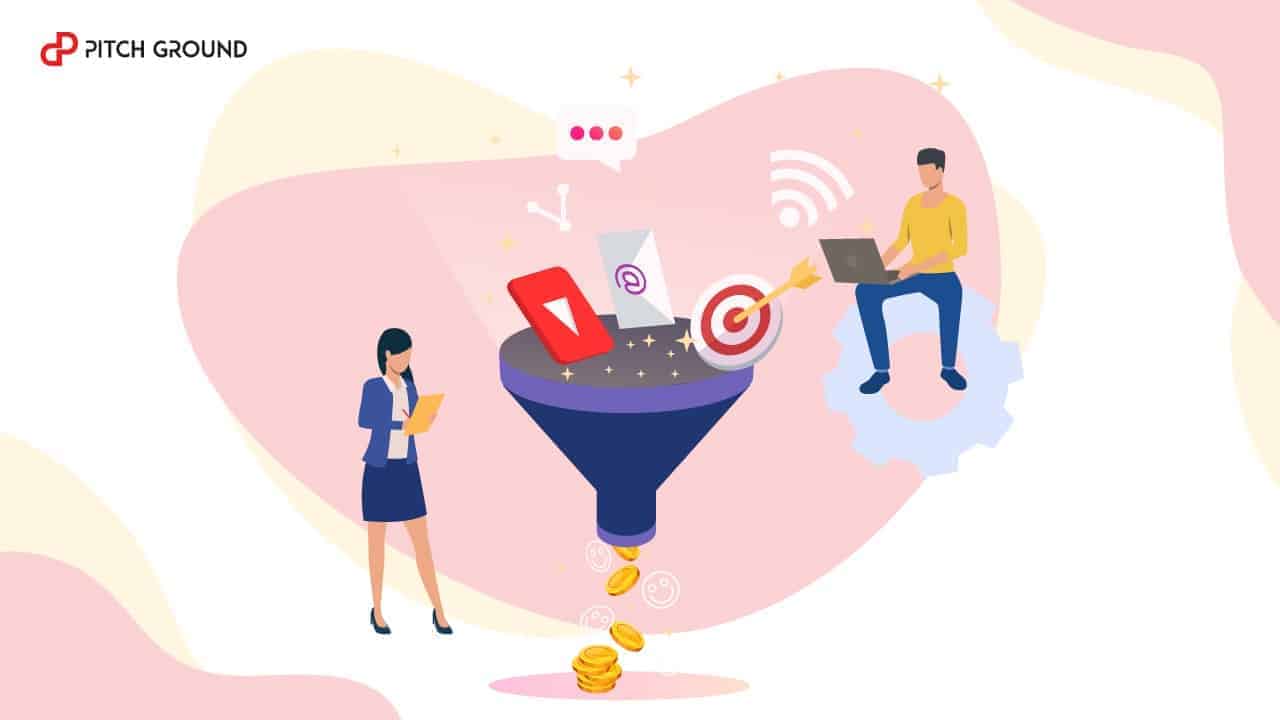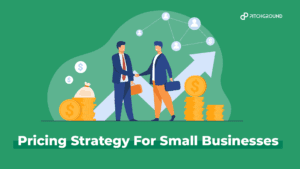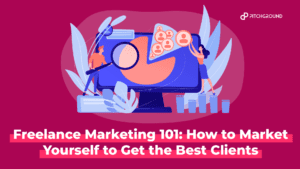In today’s world of technology and social media, attention is precious. Even though the attention span of an average visitor is short, but it’s still worth it. So this article caught your attention; perhaps “marketing funnel” rang a bell.
Isn’t it?
Well, this is the beauty of content marketing. If you aren’t familiar with content marketing, then let me explain it first.
Content marketing is a process of using your content to attract, engage, and convert the new faces into customers.
So when you looked at the article title, and you clicked-through. Right?
Fascinating.
Now I have a question for you:
Have you ever considered building a marketing funnel?
Most of you reading this article might be business owners, bloggers, internet marketers, and e-commerce experts. Despite having a connection to the digital marketing world, a lot of you might not be truly aware of the essence of a marketing funnel.
If you have no idea what a marketing funnel is, then don’t panic because you’re in good hands. This article will crack open everything you need to know about building a marketing funnel.
If you run a blog or a small business or work in digital marketing, then you might have come across the terms like “list building” and “lead generation.”
But in case, if you’re just starting out in blogging or with your startup, and you have no idea what these marketing terms are, then I’ll take a moment to explain marketing funnel to you.
What’s a Marketing Funnel?
A marketing funnel is an engagement framework that allows you to attract people, build trust with them, and convert them into paying customers at some point.
Teachable defines a marketing funnel as a framework businesses use to turn strangers into customers. Plus, they also included a diagram to explain it further, which validates our definition of a marketing funnel.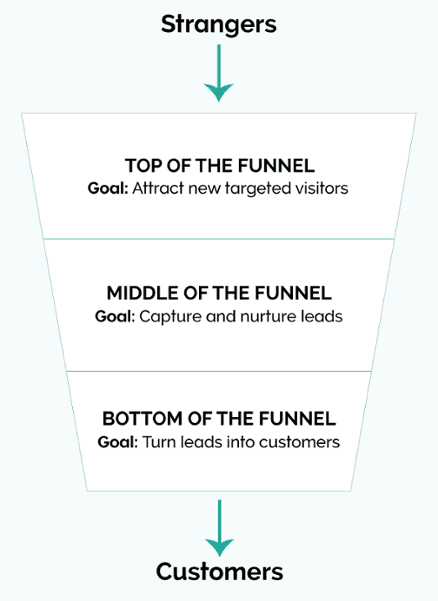
A marketing funnel isn’t limited to a certain engagement strategy, but instead, it could be a combination of a bunch of engagement tools such as email, advertising, and content.
However, the tools are somehow interconnected and serve a common agenda of attracting, engaging, and converting the audience into customers. Meaning, all the tools are coherent.
For example, if you have a lead magnet setup, then the content is going to be relevant to attract the right kind of people who might be interested in the freebie of the lead magnet.
Following are the methodologies that could be used to develop a marketing funnel:
- Run a Facebook ad campaign to get website visitors and land the visitors to a landing page where the engagement could happen. The design of the landing page, as well as the Facebook ad, must be good so that it could attract the audience.
- Write an ebook and offer it for free on your blog to build your email list. Offer something valuable in your ebook so that it entices the audience to go for it. A lot of companies use white papers or ebooks to use as an opt-in bribe and give in exchange for the visitors’ email addresses.
- Publish articles on certain topics to gain traction from organic traffic. It could lead to getting highly targeted and relevant traffic to your website. However, ranking the articles would be a huge deciding factor for this strategy to succeed. The purpose could be a product sale, blog subscribers, or a free download.
- Running social media ads, for example, you could run ads on Twitter or Quora to meet the relevant people and drive them to your social media accounts or websites for further engagement.
- YouTube video ads are mostly used to gain attention to the advertisers’ YouTube channels. They run pre-roll and mid-roll ads on YouTube videos to get the eyeballs on their channels.
- Some companies use the freemium model to bring in the prospective audience into the marketing funnel. They offer the free version of their product to get the new users on board and let the users get familiar with the product. They design their freemium version in a way that at some point the user feels to upgrade to the paid plan for extra features or to enable the full functionality of the product.
So these were some of the methodologies that are being used by the brands, bloggers, and marketers.
Let’s dive into the process of building a marketing funnel.
1: Identifying the Market Segment
Building a marketing funnel without having an identified market segment is similar to passing the football aimlessly in a soccer game. What happens is that it doesn’t make any difference and you might end up losing the ball possession.
Two things will make your market segment identification way easier.
- Demographics
Figuring out your demographics is crucial to market segment identification. Demographics are the details (of a segment of the audience) which include race, ethnicity, gender, age, education, profession, occupation, income level, and marital status.
- Buy Persona
To get started with identifying the market segment, you have to understand your buyer persona. A buyer persona is a fictional characterization of your best customer based on your product or service that you offer. It doesn’t have to be difficult since you know what you sell and who needs that.
A Hubspot article defines buyer persona as a semi-fictional representation of your ideal customer based on market research and real data about your existing customers.
Once you know your demographics and buyer persona, your job of building a marketing funnel gets easier.
So identifying the market segment is a stepping stone to building a marketing funnel as it clarifies that:
- Who you want to reach out to
- What they need to get
- What you have to offer
- Why your product could help
- What may get their attention
For instance, if you look at the SEMrush homepage, you’d make a clear statement in the website copy, which says “for digital marketing professionals.”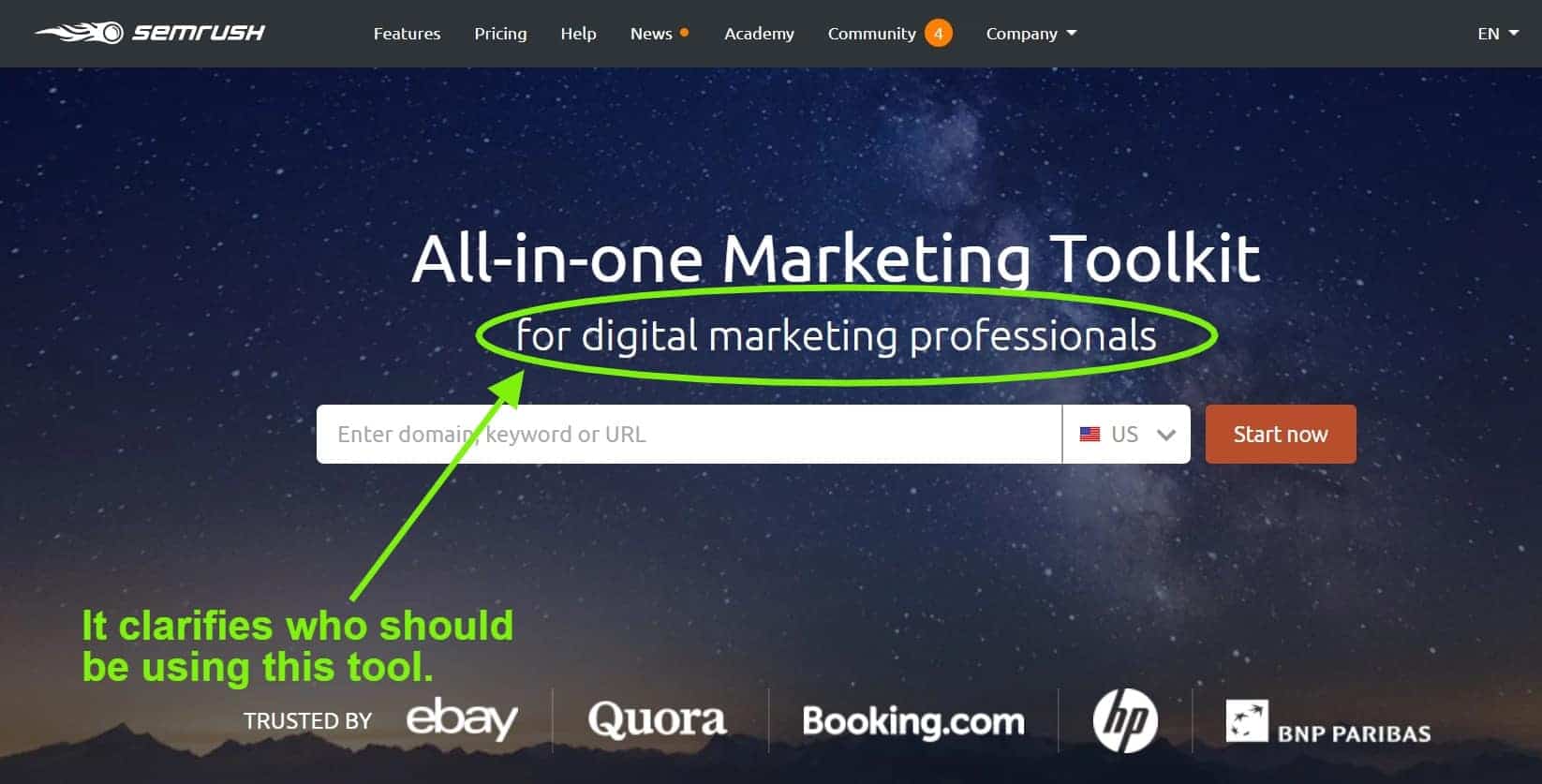
So the team behind SEMrush knows that their tool is best suited for digital marketing professionals or anyone who wants to take advantage of digital marketing practices.
Similarly, YCombinator, a startup funding community of over 4,000 founders that invest in early-stage startups has done something like that. They seem to mention the details on their website homepage as well clearly.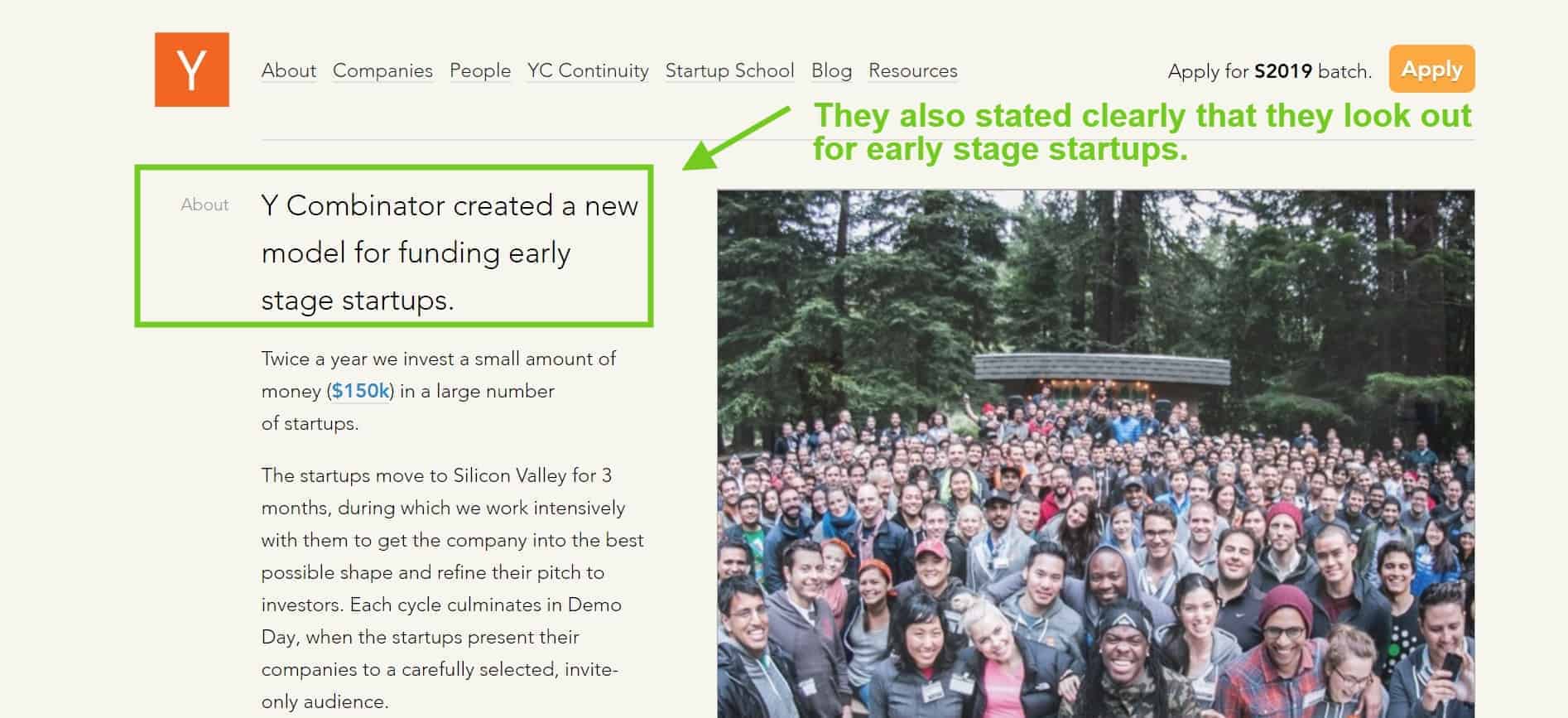
These two examples tell us that one must be explicit when it comes to targeting the audience.
Here are some key factors that could help you figure out your target audience:
Who could be searching for your product?
You can sit down for a while and ponder who might be trying to search for the products you’re making. For instance, if you design websites in Los Angeles, your target audience might be using keywords such as:
- Website designers LA
- Best website designer in Los Angeles
- Web design cost in Los Angeles
- Web design companies in LA
- Best website designer in Los Angeles
This is just an example. You must be using a keyword tool such as Keyword Tool or UberSuggest for finding the appropriate keywords to target.
Don’t get caught up in the keywords. Instead, pay close attention to your buyer persona as well. Keywords are good but don’t underestimate the power of human connection. You could understand and feel what another human might be going through way better than a computer machine.
So add that human-factor in your pursuit of finding the problems that could be solved with your product.
Who would you like to sell your product to?
It’s important to know your target audience, which is why understanding the demographics and buyer persona come in. The ideal buyers would be willing to pay for the qualities that your product has to offer. All you have to comprehend is that who that audience really is.
- Are they social media followers that are connected to you on Facebook and Twitter?
- Are they your website visitors that land on your website through search engines?
- Are they newsletter subscribers that signed up for your newsletter?
It’s way easier to sell your product to someone interested in that product category than to someone who doesn’t need that product.
For example, if you have a brand that makes leather fashion products; you should be creating content around keywords related to leather fashion products rather than dogs and cats.
Do they have the purchasing power?
Purchasing power refers to the financial capacity of the target audience. It’d be smart to figure out whether or not your target audience could afford the product.
In case, it doesn’t seem viable to offer them a high-priced product; some brands offer less-expensive versions of their products or services.
For instance, Shopify has a lite package for anyone who wants to start selling online but can’t afford to pay $29 a month for an online store.
What else do they like to buy for themselves?
Adding related products to your inventory is a huge plus for attracting and engaging the audience. Not only does it bring more sales, but it also helps in retaining the attention of the customers.
Often, bloggers add related blog posts to their blog content so that the readers could also look at relevant content. Not only does it benefit the readers, but it also helps the blog in engaging the readers.
Similarly, your favorite supermarket perhaps does this too. Have you noticed that keeping a variety of the same product so that you don’t have to go to another supermarket to buy it? So having a bunch of related products to sell allows you to increase engagement and sales.
Therefore, identifying the market segment would kickstart the process of building a marketing funnel.
2: Bring them into the Funnel
At step two, your job is to provide them with an opportunity to get on board with you. Once the target audience has been identified, it might be easier to focus on the funnel-part of the process.
However, it may seem very easy, but in reality, it’s really not. The reason is that you have to utilize various strategies to bring people into your marketing funnel. Every method has it’s own perks so you can’t pinpoint which one is better than the other one.
We’re going to discuss various methodologies that you can adapt to bring the audience into your funnel.
Write Relevant Content
The easiest way of bringing the audience into the funnel is by creating relevant content on the blog to start the engagement process. A lot of brands have been doing for years; they write content, engage the audience, and build a community around their brands.
Go and check out the blogs of Buffer, Shopify, Bluehost, Zapier, and many more companies that regularly publish fresh content on their blogs. They know the importance of putting out relevant content so that people could benefit from it and eventually sign up to the newsletter.
Build a Community on Social Media
Social media is a great avenue to attract and engage the audience. Therefore, it opens up an opportunity for the brands to develop communities of their passionate fans and loyal customers on social media.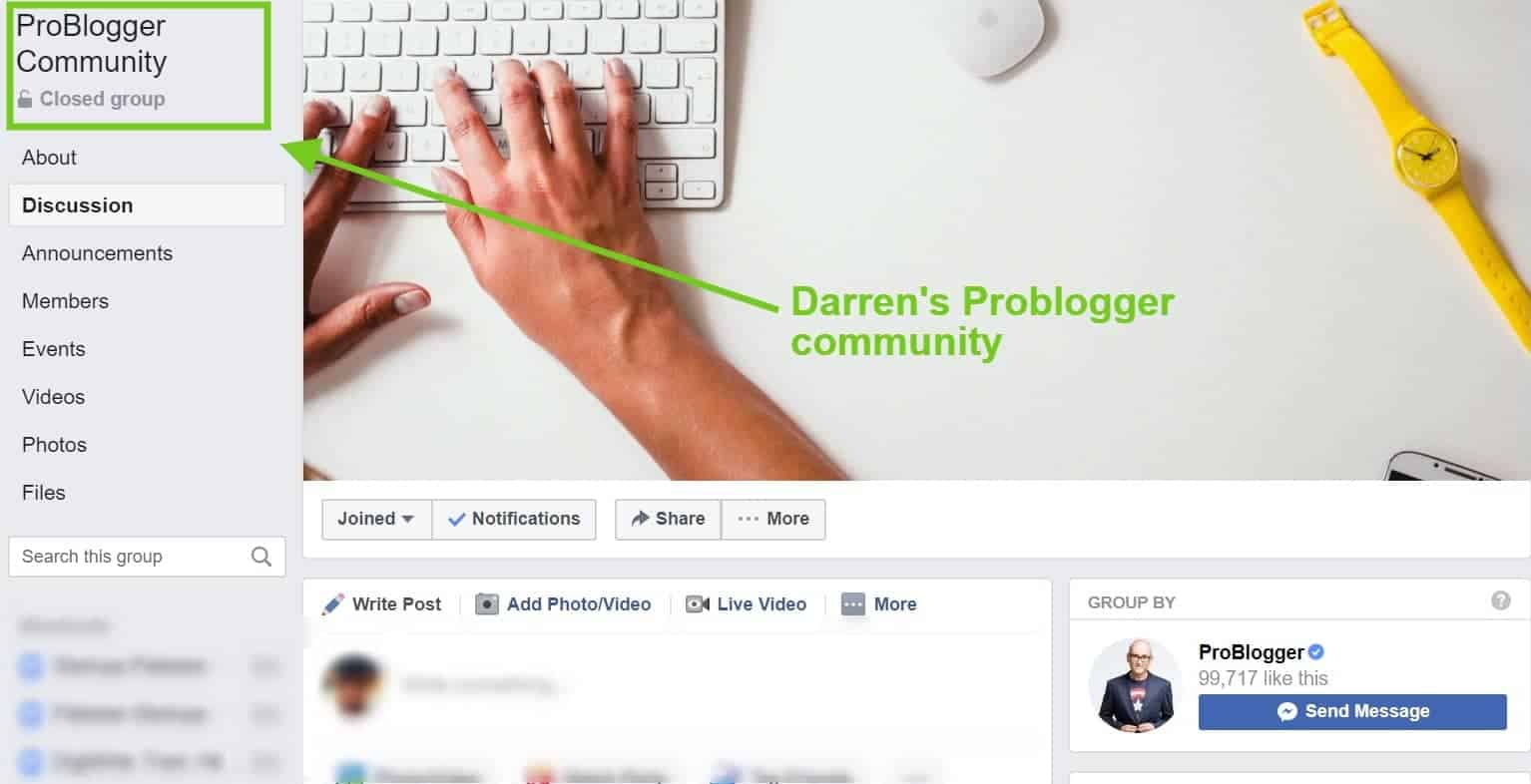
Darren Rowse has a Facebook group for Probloggers readers and subscribers where they interact, talk, share, and learn from each other.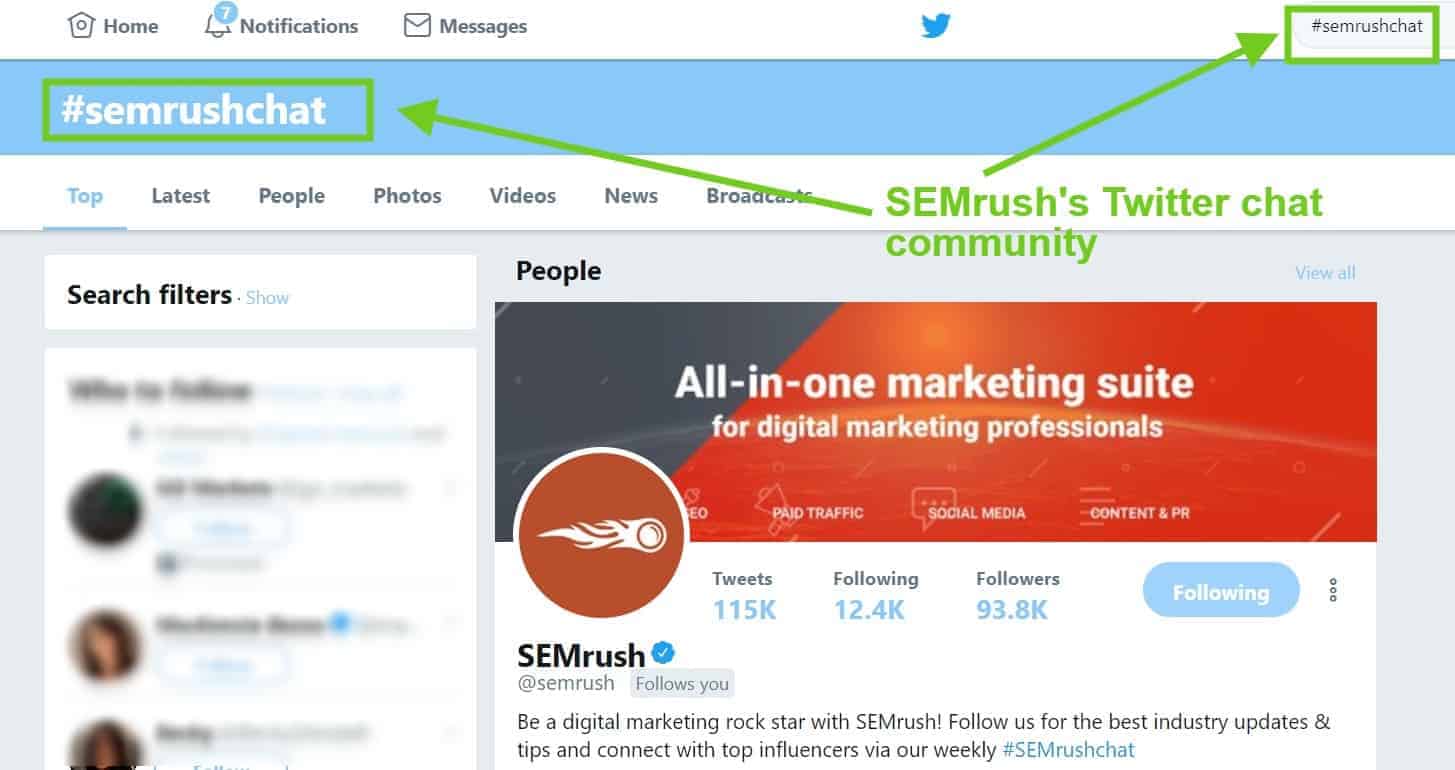
SEMrush hosts SEMrushChat on Twitter where SEMrush users and fans get together and answer the questions that the team asked every Wednesday.
Not only they interact through tweets, but they also follow each other. It’s a nice tradition of getting together with a bunch of people with similar interests.
So you can always use social media to bring people into your marketing funnel by forming a community on any social media network.
Create an Opt-in Bribe
It’s a lead magnet that drives website visitors to your landing page so that they could provide their name and email address to get a freebie. The more interesting freebie you offer, the higher the chances of sign-ups.
However, the relevance and presentation would make all the difference here. If you aren’t offering something interesting to your audience, they might not bother checking it out. Plus, don’t neglect the presentation-part of the lead magnets.
The designing of the landing pages and branding must be top-notch to attract visitors to take action.
Offer a Discount
Offering a discount is a fantastic sales and marketing strategy that businesses adopt during the holiday seasons. A seasonal discount or promo code could be distributed through social media or a secret page on the website or through the newsletter.
Moreover, one of the benefits of offering a discount is that you can bring people into your funnel as well. A lot of companies set up an automated newsletter campaign that provides the discount code when people sign up to the list.
So the audience gets the coupon code in exchange for their email address. That’s how you can use a discount offer to bring people into your marketing funnel.
Plan a Giveaway
A giveaway could be used to encourage people to enter the funnel. Who doesn’t like to win a gift? Giveaways attract the non-active subscribers and readers who have been inactive for a while.
Make sure that your giveaway offer is attractive enough to entice the audience. Many opt-in services allow you to run such a giveaway contest and help you collect the email addresses of the audience. Try Rafflecopter or Gleam.
Bringing a segment of your audience into the funnel doesn’t give you a license to bombard them with your sales pitches. Give it some time; try adding value to their work, solve their problems, and ask how you can help them more instead. You’ll find more about this in the next step.
3: Nurture the Relationship
At step three, you have to be patient and calm. Nurturing your relationship means give it some time before you try to sell something to them. If your audience starts to realize right at the beginning that you just want to sell them stuff, it could immediately backfire.
What most people do at this stage is that they can’t wait to send an offer to the email list subscribers or Facebook group members. That’s the mistake you should avoid.
You must start a conversation or an engagement or an activity other than a sales pitch to develop your relationship with your subscribers or fans that you’ve gathered through your funnel. Now those fans and subscribers in the funnel are your audiences.
Following are the things you could do to nurture your relationship with your audience.
- Start a discussion on a topic that your subscribers or group members would be interested in. It must be related to your industry so that you could impart some wisdom to them.
- Do a Q/A session with your audience. You can do that via email newsletter or Facebook group. Not only would it help the audience, but it would also build a connection with them.
- Share a valuable resource with them; it could be a video, book, article, or website that may help your audience.
- Highlight the members who ask great questions or reach out to you to thank you for your help. It motivates people to keep up and respond to you enthusiastically.
- Scheduling an automated email campaign could make a difference. You can pick the topic that you used in your lead magnet and extend it further or use a similar topic to talk about in your email campaign. Make sure that the content is exclusively available to the subscribers who came in through your marketing funnel.
Spend a few weeks in nurturing your relationship with the audience. Once companies nurture their connections with the subscribers this way, they build a solid foundation of their relationship with the audience.
It may not quickly give them paid customers, but in the long run, not only some of the subscribers turn into the paying customers, but they also spread the word about the company.
4: Make an Offer
At this point, you’d know that you’ve provided something valuable at the beginning, developed a relationship over the course of time, and now you can ask for something in return.
There is a difference in “taking” and “asking.” Therefore, the subtle difference between the two should also reflect on your offer.
You should prefer asking rather than taking, and if the audience still doesn’t want to buy, be okay with it. The reason is that there would be a million opportunities in the future so don’t sabotage your relationship with the audience.
Let’s assume that you haven’t asked for anything yet. Now, you’re a few weeks in, try coming up with a great offer that your audience can’t refuse. Remember that sending any random offer is the easy part. You must spend a good amount of time in creating an irresistible offer.
You can also wait for the best time to send out that email. For instance, if it’s August or September, wait till the Black Friday, and then send an offer with a discount.
Holiday seasons are usually when people buy stuff because many companies offer discounts during that time.
It shouldn’t surprise you that sending an offer isn’t your ultimate goal here. Instead, keeping your subscribers and the loyal audience happy might be something you should focus on.
You can always send out great deals and offers, but if subscribers start to feel overwhelmed or pressured to buy from you, then it’s downhill from here.
What’s the takeaway?
A marketing funnel is a fantastic opportunity to generate leads or build email lists. A lot of people pull this off through interesting PDF ebooks or checklists, but it doesn’t guarantee that it would yield great results.
The key to winning at building a marketing funnel is that you don’t sound salesy at all. The ideal environment to take your marketing funnel to the next level would be built on the delivery of value.
Neil Patel delivers so much value through his content. Have you ever received an email from him to buy his course or book? I reckon you have not. He doesn’t push readers to buy his products’ subscriptions, but instead, he focuses on the delivery of value.
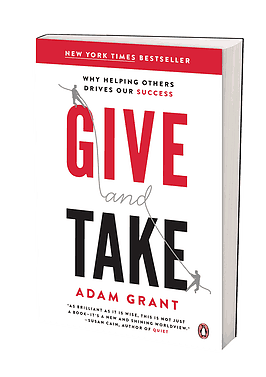
Adam Grant explained the difference between the givers and takers in his book called Give and Take. Neil is certainly a giver.
So when you build your marketing funnel, try to give way more than you ask for because givers always win.
What else would you like to add to the topic?
Let’s talk in the comments section.
